Aviation insurance poised for a turnaround
The 2014 major air catastrophes1
On March 8, flight MH 370 of Malaysia Airlines mysteriously disappears between Kuala Lumpur and Beijing with 239 people on board. According to Allianz, aviation policy leading insurer, the cost of insured losses is estimated at nearly 480 million USD.
On July 17, a second major catastrophe involving Malaysia Airlines struck. Flight MH17, probably shot down by a missile, crashed in eastern Ukraine claiming 298 lives. Insurable losses are estimated between 500 and 600 million USD.
Six days later on July 23, an ATR-72-500 of the Taiwanese company TransAsia Airways, crash landed on a resort island in the archipelago, claiming the lives of 48 people.
 Aircraft crash © Mihai.crisan, CC BY-SA 3.0 Aircraft crash © Mihai.crisan, CC BY-SA 3.0 |
On July 24, on the eve of Taiwan crash, aviation insurers awoke on a new air catastrophe. On the night of July 23 to 24, flight AH 5017 of Air Algeria linking Ouagadougou (Burkina Faso) to Algiers crashed over Mali with 116 people on board.
To make the picture worse, aviation insurers learn that 11 aircrafts and the terminal facilities of Tripoli airport (Libya) are destroyed during the month of July as a result to the fighting between rival militias seeking control over the airport. The total damage, estimated at more than 400 million USD, is to the sole charge of war risk insurers.
Gross written premiums per year: 2000-2014
in billions USD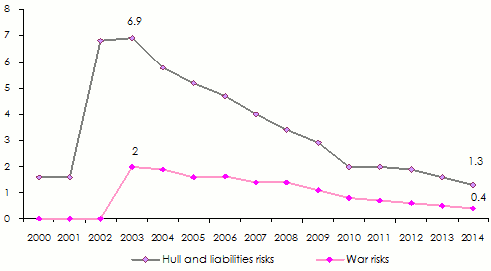 Source: PVIE 1 As at the end of September 2014
Source: PVIE 1 As at the end of September 2014 Increasing premiums forecasts
The five major catastrophes that had struck within five months, three of which in just one week, landed with a heavy bill for aviation insurers.
This series of losses has disrupted market outcome whose only response is based on a sudden increase of insurance premiums. A second historical increase of contributions dues (following that of the nine eleven attacks) is the expected scenario for the next air fleet renewal.
After the attacks of September 11, 2001, premium rates went suddenly up threefold, with the volume of hull and liability revenues reaching a historical peak of 6.9 billion USD in 2003. In addition, war risks plan has been withdrawn from standard covers. It is ever since underwritten on a separate policy and placed on a specific market which also reached a peak of 2 billion USD of premiums in 2003. Aviation market has, therefore, reported 8.9 billion USD of premiums during this same year.
Despite the occurrence of several events, easily absorbed by the market, the low loss experience reported since 2001 has led to a continuous decrease in premiums of around 10 to 20% per year. The level of premiums written in 2014 (1.3 billion USD for hull and liability covers and 0.4 billion USD for war risks) is lower than the one reported in the years 1999 to 2001, despite a booming aircraft fleet in terms of number and sums insured.
Booming air traffic
Assessement of air traffic’s evolution in 2030
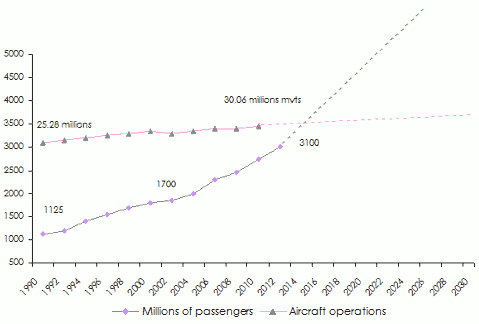 Sources: Willis and the OPECST (parliamentary office for evaluating scientific and technological choices)
Sources: Willis and the OPECST (parliamentary office for evaluating scientific and technological choices) Growing number of passengers
During the last thirteen years (2000-2013), passenger air traffic has reported unprecedented increases. In 2013, 3.1 billion people were flown compared to 1.7 billion in 2000, an increase of 82.3%. On this basis, the International Air Transport Association (IATA) estimates that the current number of passengers is poised to double by 2030.
Likewise for the estimates made by the International Civil Aviation Organization (ICAO), whose latest annual report published by the end of 2013 shows that global air traffic doubles in size every 15 years. Therefore, the 3.1 billion passengers carried in 2013 are going to be six billions by 2030, while the number of takeoffs should rise from 32 million (in 2013) to 60 million by 2030. According to the same source, this increasing traffic will be more noticeable in the countries of the Asia-Pacific region.
 Airbus A380 © Flickr, CC BY-SA 3.0 Airbus A380 © Flickr, CC BY-SA 3.0 |
According to manufacturer Airbus, the world's fleet is currently made up of 12 676 aircrafts of over one hundred passengers. This fleet is poised to double by 2025 to attain 27 000 units.
It is worth noting that, despite the remarkable rise in the number of passengers, the growth rate of aircraft traffic is relatively moderate. This finding is accounted for by the growing capacity of cargo planes and by the improvement of filling capacity of these planes.
Variations of premiums and passenger traffic: 2000-2013
As shown in the graph below, the sharp drop in premiums has not been hampered by the continuing increase in the number of passengers carried.
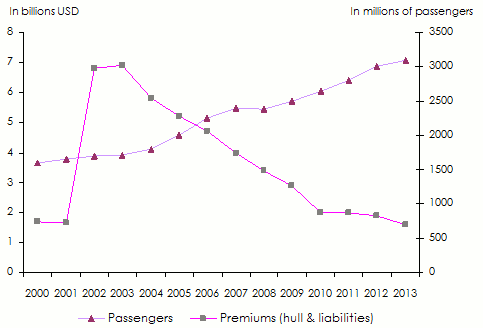 Sources: Willis & SPVIE
Sources: Willis & SPVIE Forecasts for next renewals
In early January, the 2014 premiums were estimated at 1.5 billion USD for the entire market. At the end of September, the cost of airline catastrophes that struck during the current year amounted to over 1.815 billion USD. The loss ratio far exceeded 100% for both standard and war risks. Consequently the figures portraying the last quarter of 2014 will only darken the picture.
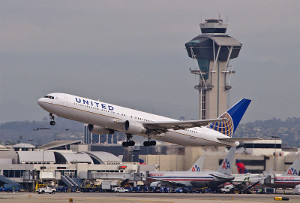 © InSapphoWeTrust, CC BY-SA 3.0 © InSapphoWeTrust, CC BY-SA 3.0 |
In view of this situation, analysts expect a sudden and significant increase in premiums which will be more noticeable for Asian airliners whose premium
increases could range from 15% to 30%. Airlines in other regions will also have to meet increases of between 10% and 15%.
According to the US rating agency AM Best, the aviation market, which has not witnessed such a high number of accidents since 2001, is able to put up with current claims. However, it is required to replenish its reserves in order to avoid any serious hardships in the future, hence the expected substantial growth in premiums.
Aviation insurance (Appendices)
Appendix 1: Price list of commercial aircrafts (January 2014)
Airbus
| Model | Price in millions USD | Number of passengers |
|---|---|---|
A318 | 71.9 | 132 |
A319 | 85.8 | 156 |
A320 | 93.9 | 180 |
A321 | 110.1 | 220 |
A319 NEO | 94.4 | 156 |
A320 NEO | 102.8 | 180 |
A321 NEO | 120.5 | 236 |
A330-200 | 221.7 | 380 |
A330-300 | 245.6 | 440 |
A350-800 | 260.9 | 270 |
A350-900 | 295.2 | 314 |
A350-1000 | 340.7 | 375 |
A380 | 414.4 | 853 |
Boeing
| Model | Price in millions USD | Number of passengers |
|---|---|---|
737-700 | 78.3 | 149 |
737-800 | 93.3 | 189 |
737-900ER | 99 | 215 |
737 MAX 7 | 87.7 | 149 |
737 MAX 8 | 106.9 | 189 |
737 MAX 9s | 113.3 | 204 |
747-8 | 367.8 | 605 |
767-300 ER | 191.5 | 350 |
777-200 ER | 269.5 | 418 |
777-200 LR | 305 | 418 |
777-300 ER | 330 | 450 |
777-8X | 360.5 | 450 |
777-9X | 388.7 | 500 |
787-8 | 218.3 | 250 |
787-9 | 257.1 | 290 |
787-10 | 297.5 | 330 |
Bombardier
| Model | Price in millions USD | Number of passengers |
|---|---|---|
Q 400 NextGen | 30.3 | 80 |
CRJ700 NextGen | 37.3 | 78 |
CRJ900 NextGen | 42.8 | 90 |
CRJ1000 NextGen | 45.8 | 100 |
CS100 | 58.3 | 125 |
CS300 | 66.5 | 145 |
Embraer
| Model | Price in millions USD | Number of passengers |
|---|---|---|
Embraer 170 | 37.8 | 78 |
Embraer 175 | 40.8 | 88 |
Embraer 190 | 45 | 114 |
Embraer 195 | 47.8 | 124 |
E 175-E2 | 46.8 | 90 |
E 190-E2 | 50 | 114 |
E195-E2 | 55 | 144 |
ATR
| Model | Price in millions USD | Number of passengers |
|---|---|---|
ATR 42-600 | 20.1 | 50 |
ATR 72-600 | 24.1 | 74 |
Appendix 2: Conventions and protocols governing air transportation
A ir transportation is a particularly complex business which requires coordination among the different players (airliners, countries, legislations, etc.). As such, several international agreements and conventions were drawn up with a view to harmonizing the regulations.
Here below is a reminder of those legislations:
| Conventions | Date and location of the agreement | Main clauses |
|---|---|---|
Warsaw Convention | 12 October1929, Warsaw (Poland) Entry into force the 12 February 1933 | This agreement has been designed to standardize some of the rules applied in international air transport. It sets the first framework of third party liability in the event of bodily injury or material damage, with compensation fees amounting to 10 000 USD per passenger. The agreement was subsequently supplemented and amended by a number of protocols and agreements. |
Chicago Convention | 7 December1944, Chicago (USA) | The Chicago Convention sets rules on air safety, the operation of civil aircraft and airports as well as crew qualifications. It also introduces the International Civil Aviation Organization (ICAO). |
Rome Convention | 7 October 1952, Rome (Italy) | This agreement governs the damage caused by foreign aircrafts and sustained by third parties on the ground. |
Hague Protocol | 18 September1955, The Hague (Netherlands ) Entry into force 1st August 1963 | This protocol has changed the deadline for reporting damage, revising the cost of compensation fixed by the Warsaw Convention upwards, setting the amount at 20 000 USD. |
Guadalajara Convention | 18 September 1961, Guadalajara (Mexico) | It amends some provisions of the Warsaw Convention (as amended in 1955 at The Hague) and incorporates the concept of transportation sub-contracting, distinguishing between the actual carrier and the contracting carrier. The agreement also specifies the liabilities of stakeholders for each type of air transport. |
Guatemala Protocol | 8 March 1971, Guatemala | The Protocol amends, again, some provisions of the Warsaw Convention (as amended in 1955 and 1961) and provides an opening to the issuance of public transportation bonds. It also redefines the carrier’s liabilities and the calculation of compensation fees in the event of bodily injury or material damage. |
Additional Protocols N°1, N° 2, N°3 and N°4 | 25 September 1975, Montreal (Canada) | These protocols amend some provisions of the Warsaw Convention (as amended in 1955, 1961 and 1971). They reformulate the procedure for calculating compensation fees and define the carrier's liability in case of mail and freight shipments. |
IATA Intercarrier International Agreements (IIA) and Montreal Inter-Carrier Agreement (MIA) of the International Air Transport Association (IATA) | 31 October 1995, Kuala Lumpur (Malaysia) 3 April 1996, Montreal (Canada) | Both agreements, which apply to IATA member airliners, are designed to scale up the third party liability system by improving the conditions of compensation in cases of international air accidents. |
Montreal Convention | 28 May 1999, Montreal (Canada) Coming into force the 4 November 2003 | The Montreal Convention has been designed to improve conditions for compensation of passengers. It is a modern and comprehensive agreement that summarizes all the above mentioned protocols. It provides an objective outright liability of up to 171 000 USD, (100 000 SDR, Special Drawing Rights as defined by the International Monetary Fund). This limit could be abolished in case of probable cause for carrier’s fault. Today, the compensation awarded under "the passengers’ third party liability" principle depends on the nationality of the victim, age, socioeconomic status, marital status, etc. It is worth noting that the states that have not signed the Montreal Convention remain subject to the Warsaw Convention (as amended in 1955, 1961, 1971 and 1975). |
Evolution of compensations fees fixed under third party liability policy
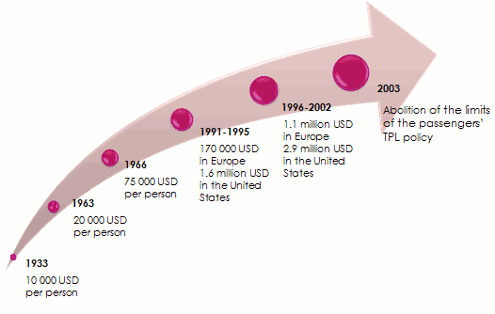 Source: Atlas Magazine, N° 18, February 2005
Source: Atlas Magazine, N° 18, February 2005 Appendix 3: Air Traffic Control (ATC) the business seen from the backstage
"There are 20 000 airworthy aircrafts in the world. Each plane carries out about four trips a day to reach a total of 80 000 flights per day. There are 5 000 planes in the sky at any time of the day”, according to the website Planetoscope.com site.
For each flight, from takeoff to landing, air traffic controllers must ensure the timing of a series of simultaneous and precise operations to avoid any possible collision between aircraft operating at very high speeds and generally converge to the same terminals. Misjudgment of the path of an aircraft can be of serious consequences. This is the work of air traffic controller, an exhausting job for sure, but more importantly, a job where no room is for error.
The air traffic controller is an engineer in the art of supervising air traffic. He is responsible for managing traffic and ensuring the flow and safety of traffic.
Air traffic controller carries out his duty from a control tower (at an airport) or from a control room located in an area of activity. He keeps track of each aircraft by means of a radar and communicate with pilots by means of a radio contact. He provides them with clear instructions on the track to take, when to run, take off and then land. Once in the air, he shows them the route and altitude to take.
When several aircrafts change course to avoid a zone of atmospheric turbulence, the controller must anticipate and make immediate decisions to avoid air collisions.
Given the immensity of the airspace and the large number of aircrafts in traffic, control work is assigned to multiple controllers in several countries. Airspace is divided into portions or sectors. Each of which is monitored by a single controller. The air space around our planet is almost covered. The air traffic controller manages generally twenty aircraft simultaneously.
When in motion, planes fly from one sector to another, from one controller to another. Before an airplane leaves an air sector, the controller relays it to the next control unit, whether within one country or in neighboring countries. The language of communication between pilots and controllers is English.
Appendix 4: Main organisations of civil aviation
| Name of the organisation | Members | Head office | Date of establishment |
|---|---|---|---|
International Air Transport Association (IATA) | 240 airlines | Montreal (Canada) | April 1945, Havana (Cuba) |
International Civil Aviation Organization (ICAO) | 191 member States | Montreal (Canada) | November 1944 Montreal |
International Federation of Airline Pilots Association (IFALPA) | 100 000 pilots and engineers from 100 countries | Montreal (Canada) | 1948, Montreal |
International Federation of Air Traffic Controllers (IFATCA) | 131 member States | Montreal (Canada) | October 1961 Amsterdam (Netherlands) |
African Civil Aviation Commission (AFCAC) | 54 African countries | Dakar (Senegal) | 1964 Addis-Abeba (Ethiopia) |
African Airlines Association (AFRAA) | 34 African airlines | Nairobi (kenya) | April 1968 Accra (Ghana) |
Arab Air Carriers Organisation (AACO) | 27 Arab airlines | Amman (Jordan) | 1965 |
Association of Asia Pacific Airlines (AAPA) | 16 airlines | Kuala Lumpur (Malaysia) | 1965 |
Airports Council International Europe (ACI Europe) | 450 airports in 45 European countries | Brussels (Belgium) | 1991 |
Association of European Airlines (AEA) | 30 airlines | Brussels (Belgium) | 1954 Strasbourg (France) |
Eurocontrol: European Organisation for the Safety of Air Navigation | 40 member countries | Brussels (Belgium) | 1960 |
Airport Association of CIS Civil Aviation | 246 organisations representing 22 countries | Moscow (Russia) | 18 December 1990 |
